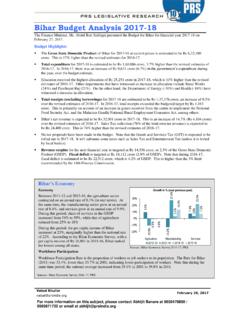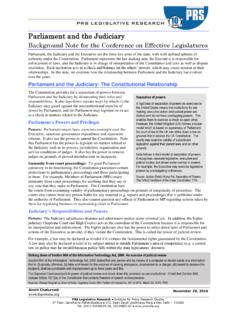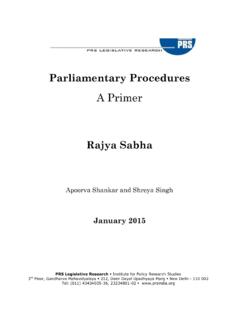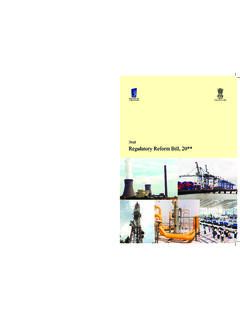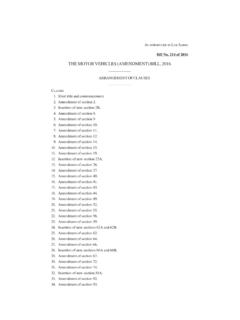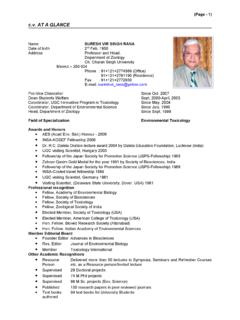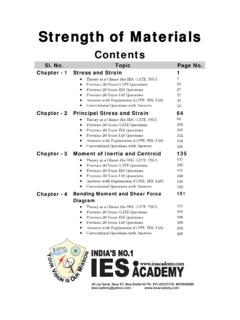Transcription of Overview of Ground Water in India - PRS | Home
1 Overview ofGround Water in IndiaRoopal Suhag February 20161 The Standing Committee on Water Resources examined the subject Review of Ground Water scenario, need for a comprehensive policy and measures to address problems in the country with particular reference to (i) dark blocks, and (ii) contamination of underground Water by certain industries and submitted their report in December 2015. The Committee s recommendations are summarised in the annexure to the note. Committees usually review the action taken by the government on their recommendations, a few months after the report is released.
2 In this context, we present an analysis of the Ground Water scenario in the country. This note maps the indicators regarding availability of Ground Water in the country, the policy framework and some key issues with regard to the sector. Overview of Ground Water in India Introduction Ground Water is the Water that seeps through rocks and soil and is stored below the Ground . The rocks in which Ground Water is stored are called aquifers. Aquifers are typically made up of gravel, sand, sandstone or limestone.
3 Water moves through these rocks because they have large connected spaces that make them permeable. The area where Water fills the aquifer is called the saturated zone. The depth from the surface at which Ground Water is found is called the Water table. The Water table can be as shallow as a foot below the Ground or it can be a few hundred meters deep. Heavy rains can cause the Water table to rise and conversely, continuous extraction of Ground Water can cause the level to fall. Figure 1 illustrates the major definitions used in the context of groundwater.
4 Figure 1: Graphical representation of Ground Water and associated terms The underground (hydrogeological) setting of Ground Water defines the potential of this resource and its vulnerability to irreversible This setting in India can be divided into following categories, which are described below: Hard-rock aquifers of peninsular India : These aquifers represent around 65% of India s overall aquifer surface area. Most of them are found in central peninsular India , where land is typically underlain by hard-rock formations.
5 These rocks give rise to a complex and extensive low-storage aquifer system, where in the Water level tends to drop very rapidly once the Water table falls by more than 2-6 meters. Additionally, these aquifers have poor permeability* which limits their recharge through rainfall. This implies that Water in these aquifers is non- replenishable and will eventually dry out due to continuous usage. * Permeability refers to the ability of a rock to transmit Water .
6 2 Alluvial aquifers of the Indo-Gangetic plains: These aquifers, found in the Gangetic and Indus plains in Northern India have significant storage spaces, and hence are a valuable source of fresh Water supply. However, due to excessive Ground Water extraction and low recharge rates, these aquifers are at the risk of irreversible overexploitation. Ground Water availability As of April 2015, the Water resource potential or annual Water availability of the country in terms of natural runoff (flow) in rivers is about 1,869 Billion Cubic Meter (BCM) However, the usable Water resources of the country have been estimated as 1,123 BCM/year.
7 This is due to constraints of topography and uneven distribution of the resource in various river basins, which makes it difficult to extract the entire available 1,869 BCM/year. Out of the 1,123 BCM/year, the share of surface Water and Ground Water is 690 BCM/year and 433 BCM/year respectively. Setting aside 35 BCM for natural discharge*, the net annual Ground Water availability for the entire country is 398 The overall contribution of rainfall to the country s annual Ground Water resource is 68% and the share of other resources, such as canal seepage, return flow from irrigation, recharge from tanks, ponds and Water conservation structures taken together is 32%.
8 4 Due to the increasing population in the country, the national per capita annual availability of Water has reduced from 1,816 cubic metre in 2001 to 1,544 cubic metre in This is a reduction of 15%. Figure 2: Depth to Water level (pre-monsoon, 2014) Note: m bgl denotes meters below Ground level. Sources: Central Ground Water Board; PRS. The figure indicates that Ground Water is available at a lower level in the north-western region of the country. There are other significant pockets across the country where the depth of the Water level is more than 10 metres.
9 This implies that one has to dig deeper to reach the Water table in these regions. When the Ground Water level crosses 10 metres, sophisticated equipment is required to extract it. * Natural discharge occurs as seepage to Water bodies or oceans in coastal areas and as transpiration by plants whose roots extend up to the Water table. Table 1: Statistics regarding Water resources in India Parameter Unit (Billion Cubic Meter/Year) Annual Water availability 1,869 Usable Water 1,123 Surface Water 690 Ground Water 433 Sources: Water and Related Statistics, April 2015, Central Water Commission; PRS.
10 3 Ground Water resources in the country are assessed at different scales within districts, such as blocks/mandals/talukas/watersheds. Ground Water development is a ratio of the annual Ground Water extraction to the net annual Ground Water availability. It indicates the quantity of Ground Water available for use. Table 2 below compares the level of Ground Water development in the country over the past two decades. Table 2: Comparative status of level of Ground Water development in India in the past 20 years Level of Ground Water development Explanation % of districts in 1995 % of districts in 2004 % of districts in 2009 % of districts in 2011 0-70% (Safe) Areas which have Ground Water potential for development 92 73 72 71 70-90% (Semi-critical) Areas where cautious Ground Water development is recommended 4 9 10 10 90-100% (Critical)


